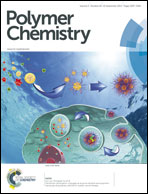Amphiphilic block copolymers featuring a reversible hetero Diels-Alder linkage†
Abstract
The present article reports the preparation of a novel class of switchable amphiphilic diblock copolymers with a temperature switchable linkage. Reversible addition fragmentation chain transfer (RAFT) polymerization was used to synthesize the individual blocks: for the preparation of the non-polar block, i.e. poly(isoprene-co-styrene) (P(I-co-S)) (9200 g mol−1 ≤ Mn ≤ 50 000 g mol−1, 1.22 ≤ Đ ≤ 1.36), a chain transfer agent (CTA, 3-((2-bromo-2-methylpropanoyl)oxy)propyl 2-(((dodecylthio)carbonothioyl)thio)-2-methylpropanoate) carrying a bromine group was employed, ready for subsequent cyclopentadienyl (Cp) transformation. For the preparation of the polar block, triethylene glycol methyl ether acrylate (TEGA) was polymerized (6600 g mol−1 ≤ Mn ≤ 35 000 g mol−1, 1.12 ≤ Đ ≤ 1.30) using a RAFT agent carrying a phosphoryl Z-group, which is able to undergo hetero Diels-Alder (HDA) ligation with Cp moieties. Both building blocks were conjugated at ambient temperature in the presence of ZnCl2 as catalyst yielding the amphiphilic block copolymer P(I-co-S)-b-PTEGA (16 000 g mol−1 ≤ Mn ≤ 68 000 g mol−1, 1.15 ≤ Đ ≤ 1.32). To investigate the bonding/debonding capability of the HDA linkage, high temperature nuclear magnetic resonance (HT-NMR) spectroscopy, high temperature dynamic light scattering (HT-DLS) and high temperature size exclusion chromatography (HT-SEC) were carried out, evidencing that efficiently switchable amphiphilic block copolymers were generated (>4 cycles).

- This article is part of the themed collection: Celebrating The Five-Year Anniversary of Polymer Chemistry

 Please wait while we load your content...
Please wait while we load your content...